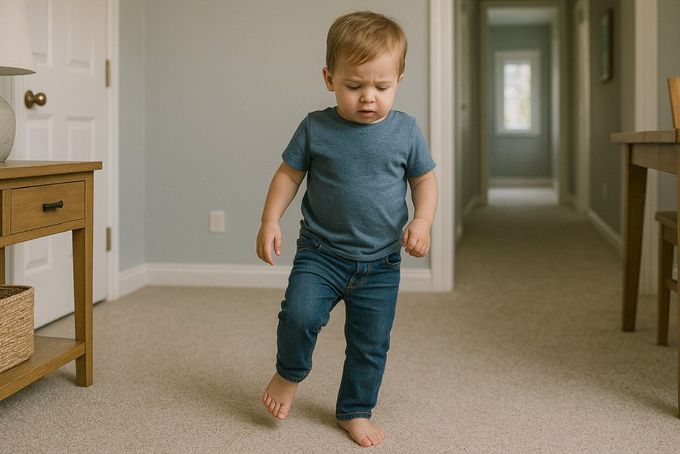Why Is My Toddler Limping? Understanding Antalgic Gait in Kids
An antalgic gait is a limp caused by pain. In toddlers, it often looks like shortened steps, refusal to bear weight, or crawling instead of walking. The treatment depends on the severity, ranging from rest to antibiotics and medical intervention.
Published June 8, 2025

Toddlers are still figuring out how to walk. Their muscles are weak, their coordination is clumsy, and their bones are softer than older kids'. It's common for them to trip, fall, or limp after play. Most of the time, these are minor hiccups in development. But not always.
If you’re wondering what causes a limping gait in children or what the term “antalgic gait” really means, keep reading. This guide walks you through the definition, causes, and treatment of pain-related limping in toddlers.
Antalgic Gait Meaning and Pattern
Antalgic gait, by definition, is a protective walking pattern toddlers adopt to avoid pain [1]. It’s the most common medical term for a limping gait due to discomfort. The antalgic gait pattern in toddlers shows up as shorter stance time, noticeable limping, and a clear shift away from the painful leg.
In older kids or adults, that might look like shorter steps or a slight hobble. In toddlers, it's often more dramatic: crawling instead of walking, clinging to furniture, or outright refusal to stand.
Key signs:
- Shorter stance time on one leg
- Reluctance or refusal to bear weight
- A change in walking pattern that starts suddenly
Some toddlers can point to the pain. Others just wince, whine, or avoid standing. In my clinic, if a toddler limps during play or wakes up crying from leg pain, I take it seriously.
Causes of Antalgic Gait in Toddlers (Ranked by Urgency)
One of the biggest myths I hear in my practice is that growing pains cause this type of limping in toddlers. They don't. True growing pains happen at night. If your kid has an antalgic gait, there is a physical cause.
Here's what may cause antalgic gait in your toddler:
1. Septic Arthritis and Osteomyelitis
Some causes of antalgic gait can include infections like septic arthritis or osteomyelitis [1]. They usually show up with fever, pain, and a sudden refusal to bear weight and are a medical emergency. This is the most urgent cause. Joint infections can destroy cartilage within hours.
Toddlers will resist all movement and may have fevers. Diagnosis often requires labs, imaging, while the doctors will treat these conditions with antibiotics, and sometimes even surgery. Make sure to visit your pediatrician to rule out these infections.
2. Toddler’s Fracture
A toddler’s fracture is a small spiral break in the tibia [2]. It can happen after a minor fall and often doesn’t show up on the first X-ray. But it hurts enough to cause limping or refusal to walk.
The child won’t walk, even when distracted. There may be no obvious trauma. These fractures are often missed on early X-rays but show up later. Casting for 3–6 weeks usually brings full recovery.
3. Transient Synovitis
Transient synovitis common post-viral hip irritation, causing sudden limping without other symptoms [3]. Toddlers look well otherwise. Most improve within 72 hours. If not, further workup is needed to rule out more serious causes.
4. Juvenile Idiopathic Arthritis
Juvenile idiopathic arthritis is one of the medical causes of a limping gait that can go unnoticed because it doesn't hurt. Chronic and subtle. Some kids don’t complain of pain [4].
You might notice a consistent limp, especially in the morning. Early treatment prevents joint damage. Delays in diagnosis are common and avoidable.
Treatment of Antalgic Gait in Toddlers
Antalgic gait treatment varies based on cause, ranging from rest for minor irritation to urgent antibiotics or casting for serious issues [1].
More serious conditions, such as infections or fractures, need a quick medical intervention. In all cases, reducing pain and restoring symmetry is the goal. Physical therapy may be needed when muscle weakness or instability mimics an antalgic gait.
If you're visiting a podiatrist, bring a video of your child walking. Many gait abnormalities in children, including antalgic gait, can disappear temporarily in a clinic setting.
- If the limp lasts more than a week, gets worse, or comes with fever, get checked immediately. And trust your gut. As a parent, you can catch things that doctors don’t always see.
- Sometimes, a limp is just a bump. Sometimes, it’s the first sign of something serious. The sooner we know, the sooner we can help your child walk with confidence again.
What Recovery From Antalgic Gait Looks Like—And How to Help
Most toddlers recover fully, but the timeline depends on the cause:
- Transient Synovitis: 1–2 weeks
- Fractures: 3–6 weeks
- Infections: Several weeks to months
- JIA: Varies, but 80% normalise gait with early treatment
You should watch for:
- Return to symmetrical walking
- No more pain complaints
- Confidence in play and movement
Physiotherapy helps with strength and coordination. If the limp is caused by muscle weakness or joint instability, don’t rush walking. Let the child guide their own pace. Let the child guide activity levels. Outdoor play often speeds up progress.
Why Proper Shoes Matter for Antalgic Gait in Kids
Bad shoes can make a good recovery harder. For toddlers with unstable or abnormal gait patterns, supportive shoes can help correct a mild limping gait pattern during recovery. Cushy soles or floppy designs make it harder for their feet and legs to align.
What to look for:
- Firm heel support
- Flexible forefoot
- Lightweight structure
When a child has an antalgic gait, even mild misalignment or instability can prolong limping or delay recovery. I’ve seen mild limps resolve simply by switching to the right shoes. Especially in kids with loose joints or flat feet.
For example, the Captain Caleb Orthopaedic Sandals from First Walkers stabilise the foot and ankle, reduce strain during walking, which is crucial for toddlers, compensating for pain on one side.
Recognising the Painful Walking Patterns Early
Understanding antalgic gait means recognising when a toddler’s limp is more than just a developmental phase. As discussed throughout this article, an antalgic gait is a pain-related walking pattern that signals an underlying issue, from fractures to infections to inflammatory or neurological conditions.
While some causes are mild and resolve quickly, others require urgent medical attention. By learning the typical signs, patterns, and treatment options, parents can act early and confidently.
This article set out to explain the meaning, causes, and treatment of antalgic gait in toddlers, and it has. What matters most is this: if your child is limping, don’t guess. Watch carefully. Ask questions. And never hesitate to seek help.
If your toddler is recovering from an injury or walking with an uneven gait, supportive footwear can make a real difference. First Walkers offers orthopaedic sneakers designed for stability, comfort, and early-stage walkers.
References:
- R. Vezzetti and B. Bordoni, “Antalgic GAit in children,” StatPearls - NCBI Bookshelf, Jun. 12, 2023. Available: https://www.ncbi.nlm.nih.gov/books/NBK535385/
- M. C. Noe, D. E. Jarka, M. K. Sinclair, and C. W. Grote, “Toddler’s fracture: an updated guide on evaluation and management,” Journal of Pediatric Orthopaedics B, Sep. 2024, doi: 10.1097/bpb.0000000000001210. Available: https://pubmed.ncbi.nlm.nih.gov/39730124/
- C. C. Whitelaw and M. A. Varacallo, “Transient synovitis,” StatPearls - NCBI Bookshelf, Mar. 01, 2024. Available: https://www.ncbi.nlm.nih.gov/books/NBK459181/
- C. C. Whitelaw and M. A. Varacallo, “Transient synovitis,” StatPearls - NCBI Bookshelf, Mar. 01, 2024. Available: https://www.ncbi.nlm.nih.gov/books/NBK459181/
Disclaimer: First Walkers' information is intended for educational and informational purposes related to toddler footwear and feet. We encourage you to consider individual circumstances and consult qualified orthopaedists about specific conditions.
FAQs
What muscles are weak in antalgic gait?
In antalgic gait, muscle weakness isn't always the cause, but when it is, it often involves the hip abductors, quadriceps, or calf muscles. Weakness in these muscles can lead to instability, causing the child to shorten stance time to avoid discomfort.
What are the long-term effects of antalgic gait?
If untreated, antalgic gait can lead to muscle imbalances, joint stiffness, and abnormal walking patterns that persist even after the original pain resolves. In toddlers, it may also delay motor milestones or affect coordination. Early diagnosis and treatment usually prevent long-term issues.
Is antalgic gait neurological?
No, antalgic gait is not neurological. It’s a limp caused by pain, usually from injury, inflammation, or infection. Neurological gaits, by contrast, result from nerve or brain conditions and often involve coordination or muscle tone issues, not just pain avoidance.
Can back pain cause antalgic gait in kids?
Yes, back pain can cause antalgic gait in kids, though it’s less common than leg or joint pain. Conditions like discitis or spinal infections may lead a child to alter their posture or walking to avoid discomfort, resulting in a pain-driven limp.




